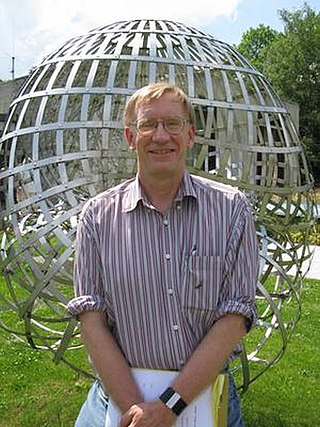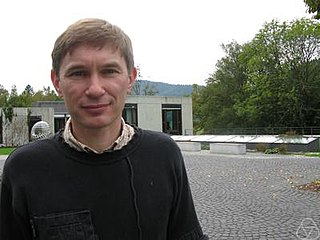
Ralph Louis Cohen (born 1952) is an American mathematician, specializing in algebraic topology and differential topology. [1]

Ralph Louis Cohen (born 1952) is an American mathematician, specializing in algebraic topology and differential topology. [1]
Cohen received his bachelor's degree from the University of Michigan in 1973 and his Ph.D. in 1978 from Brandeis University where he worked under the supervision of Edgar H. Brown, Jr. His thesis was titled On Odd Primary Stable Homotopy Theory. He did his postdoctoral training as an L.E. Dickson Instructor at the University Chicago, and then became an Assistant Professor of Mathematics at Stanford University in 1980. In 1983, he became an Associate Professor and was promoted to Full Professor in 1987. Cohen is now the Barbara Kimball Browning Professor of Mathematics at Stanford. He was Chair of the Mathematics Department from 1992 to 1995, from 1999 to 2009 he was the Director of the Mathematics Research Center at Stanford, and from 2010 to 2016 was the Senior Associate Dean for the Natural Sciences in the School of Humanities and Sciences.
Cohen has been a visiting professor at Princeton University, the University of Oxford, the University of Cambridge, Paris Diderot University, Paris 13 University, the University of Lille, and the University of Copenhagen. He was a founding editor of both the Journal of Topology and Geometry & Topology.
Cohen has been the Ph.D. supervisor to over 30 doctoral students, including Ulrike Tillmann and Ernesto Lupercio.
In 1985, Cohen proved the Immersion Conjecture, which says that each smooth, compact n-manifold has an immersion in Euclidean space of dimension , where is the number of ones in the binary expansion of . In 1991, Cohen, together with Frederick Cohen, Benjamin Mann, and R. James Milgram gave a complete description of the algebraic topology of the space of rational functions, and in the following years he made several contributions to the study of related moduli spaces. In 1995 Cohen, John D. S. Jones, and Graeme Segal introduced an approach for understanding the homotopy theory underlying Floer homology theory in Symplectic geometry. Since 2002 Cohen has been one of the developers and contributors to the theory of String topology, which was introduced originally by Moira Chas and Dennis Sullivan.
In 1995, Cohen was a founder of the Stanford University Math Camp (SUMaC), a summer camp for mathematically talented high school students. In 2002 Cohen received the Distinguished Teaching Award from Stanford University, and in 2005 he became a Bass Fellow in Undergraduate Education at Stanford.
In 1982 Cohen was a Sloan Research Fellow. In 1983 he was an invited speaker at the International Congress of Mathematicians in Warsaw. In 1984 he received the Presidential Young Investigator Award. In 1988 he received an NSF International Award, in 2010 he served on the Executive Committee of the American Mathematical Society, and in 2012 he was elected a Fellow of the American Mathematical Society.

Algebraic topology is a branch of mathematics that uses tools from abstract algebra to study topological spaces. The basic goal is to find algebraic invariants that classify topological spaces up to homeomorphism, though usually most classify up to homotopy equivalence.
Daniel Gray Quillen was an American mathematician. He is known for being the "prime architect" of higher algebraic K-theory, for which he was awarded the Cole Prize in 1975 and the Fields Medal in 1978.
In gauge theory and mathematical physics, a topological quantum field theory is a quantum field theory which computes topological invariants.
Algebraic K-theory is a subject area in mathematics with connections to geometry, topology, ring theory, and number theory. Geometric, algebraic, and arithmetic objects are assigned objects called K-groups. These are groups in the sense of abstract algebra. They contain detailed information about the original object but are notoriously difficult to compute; for example, an important outstanding problem is to compute the K-groups of the integers.
In mathematics, Khovanov homology is an oriented link invariant that arises as the cohomology of a cochain complex. It may be regarded as a categorification of the Jones polynomial.
In mathematics, Floer homology is a tool for studying symplectic geometry and low-dimensional topology. Floer homology is a novel invariant that arises as an infinite-dimensional analogue of finite-dimensional Morse homology. Andreas Floer introduced the first version of Floer homology, now called symplectic Floer homology, in his proof of the Arnold conjecture in symplectic geometry. Floer also developed a closely related theory for Lagrangian submanifolds of a symplectic manifold. A third construction, also due to Floer, associates homology groups to closed three-dimensional manifolds using the Yang–Mills functional. These constructions and their descendants play a fundamental role in current investigations into the topology of symplectic and contact manifolds as well as (smooth) three- and four-dimensional manifolds.

In mathematics, an immersion is a differentiable function between differentiable manifolds whose differential pushforward is everywhere injective. Explicitly, f : M → N is an immersion if

Dennis Parnell Sullivan is an American mathematician known for his work in algebraic topology, geometric topology, and dynamical systems. He holds the Albert Einstein Chair at the Graduate Center of the City University of New York and is a distinguished professor at Stony Brook University.
In mathematics, elliptic cohomology is a cohomology theory in the sense of algebraic topology. It is related to elliptic curves and modular forms.
In knot theory, an area of mathematics, the link group of a link is an analog of the knot group of a knot. They were described by John Milnor in his Ph.D. thesis,. Notably, the link group is not in general the fundamental group of the link complement.

Ronald Brown FLSW is an English mathematician. Emeritus Professor in the School of Computer Science at Bangor University, he has authored many books and more than 160 journal articles.
String topology, a branch of mathematics, is the study of algebraic structures on the homology of free loop spaces. The field was started by Moira Chas and Dennis Sullivan.

Gunnar E. Carlsson is an American mathematician, working in algebraic topology. He is known for his work on the Segal conjecture, and for his work on applied algebraic topology, especially topological data analysis. He is a Professor Emeritus in the Department of Mathematics at Stanford University. He is the founder and president of the predictive technology company Ayasdi.
In algebraic K-theory, the K-theory of a categoryC (usually equipped with some kind of additional data) is a sequence of abelian groups Ki(C) associated to it. If C is an abelian category, there is no need for extra data, but in general it only makes sense to speak of K-theory after specifying on C a structure of an exact category, or of a Waldhausen category, or of a dg-category, or possibly some other variants. Thus, there are several constructions of those groups, corresponding to various kinds of structures put on C. Traditionally, the K-theory of C is defined to be the result of a suitable construction, but in some contexts there are more conceptual definitions. For instance, the K-theory is a 'universal additive invariant' of dg-categories and small stable ∞-categories.
Ernesto Lupercio is a Mexican mathematician. He was awarded the ICTP Ramanujan Prize in 2009, "for his outstanding contributions to algebraic topology, geometry and mathematical physics."
Richard James Milgram is an American mathematician, specializing in algebraic topology. He is the son of mathematician Arthur Milgram.
Aldridge Knight Bousfield, known as "Pete", was an American mathematician working in algebraic topology, known for the concept of Bousfield localization.

Alexander A. Voronov is a Russian-American mathematician specializing in mathematical physics, algebraic topology, and algebraic geometry. He is currently a Professor of Mathematics at the University of Minnesota and a Visiting Senior Scientist at the Kavli Institute for the Physics and Mathematics of the Universe.
Frederick Ronald Cohen was an American mathematician working in algebraic topology.

Donald M. Davis is an American mathematician specializing in algebraic topology.